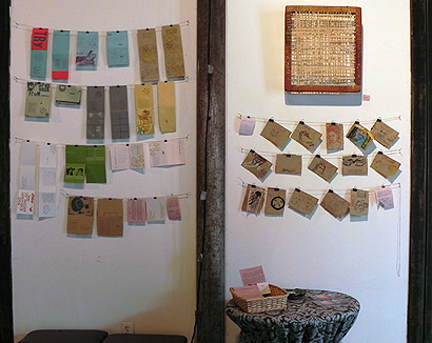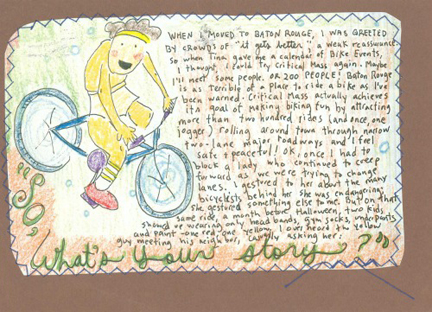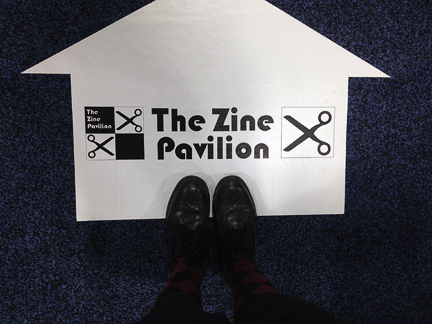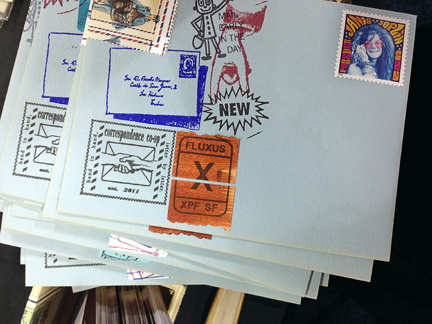I can’t quite remember when Hope Amico of Gutwrench Press first found her way to my mailbox. However, I do remember that feeling of “holy cow! What is this beautiful printed thing here in my hand?!” The postcard was a little dinged up (that’s what happens when you send soft printmaking paper through the cruel machinery of the postal system) but the scritches and scratchings only added to the mystery of the card itself.
Through a handful of addresses and cities, Hope and I have always managed to keep in touch postally. Her artists books and prints are a world unto themselves: beautifully printed, lovingly bound together, thoughtfully written. Her “Keep Writing Postcards” project is a natural extension of fine art works, a call-and-response with friends and strangers, using the medium of the post office.
Oakland-based gallery E.M. Wolfman is exhibiting “To Get A Letter, Send A Letter: Selections From the Keep Writing Postcards Project” through the month of August. Graciously, Hope took a bit of time to answer some questions for Red Letter Day readers about her process, what the “Keep Writing Postcards” project means to her, and the future of the project itself.
Jennie Hinchcliff: In general terms, can you describe for RLD readers what the “Keep Writing Postcards” project is all about?
Hope Amico: It started as a way to keep in touch with friends as I moved away and began college. I started printing one postcard a month, using the handset type and presses at my university, mailing about 60 to friends on a mailing list. Within the first year I began collaborating with friends on the cards and began offering subscriptions to strangers. By the time I was finishing up school, it had evolved into the thing it is today: each month I letterpress print a folded card, consisting of two postcards. One postcard is something I’ve designed, illustrating a story or a quotation that I like. The other half has instructions for the recipient, usually somehow related to my design. Recipients fill out their half and mail it back to me. I post it online and sometimes share them in gallery shows.
JH: Describe an average month (from start to finish) for “Keep Writing Postcards” (i.e. what’s your working process like?)
HA: Ideally, on the first of the month, all the cards for that month are in the mail. Usually they make it to the post box a few days later and sometimes get mailed as late as the middle of the month. I spend a few days working out an idea, drawing, scanning, searching clip art, writing text and revising.
Then I spend about 2 days towards the end of the month making plates and printing. I trim the cards, bring them to my home studio and spend a few hours listening to radio shows while scoring and folding, taping and stamping. At some point I remember to print mailing labels from my subscriber list spreadsheet. Sometimes this takes a minute; sometimes, on bad computer days, it can take hours, during which I reconsider the time-saving measure of printing labels. (ed note: HA! indeed…)
The last step is best. I write at least “hello” and sign my name on all the cards, writing longer notes every few cards. Sometimes I bring a stack with me if I am going out to eat alone. Then I drop them in the mail box and start again.
JH:How do you decide on each month’s theme?
HA: I have a list in my journal of potential ideas. Some months there is an event or holiday I would like to highlight or work with but sometimes I have a technique I want to work with. I try to mix it up so that some months ask for a story, followed maybe by a fill-in-the blank image or sentence and then maybe a drawing-friendly idea. That’s the ideal.
But sometimes I plan a few months ahead only to think of something more appealing to me at the last minute. I like the month to month variety but sometimes I print everything in silver for two months in a row. I want to plan two months ahead but I also like having a thoughtful but open enough prompt that many people want to respond. There is a balance between offering enough guidelines and specifics to inspire and be clear while leaving room for all the creative answers.
And some months I just want a break or want to give everyone a break or have an idea for a card without a response so I print that. Everyone needs a break from obligations to keep them fun, right?
JH: Each of the postcards that you send out are beautifully letterpressed and oftentimes incorporate an image you’ve collaborated on with another artist. Can you talk a little bit about the nature of collaboration, both in the postcards you’ve created and the works you’re receiving from participants?
HA: When I started the project, the first year was just a single postcards that I printed. Then I thought I’d try a year of collaborating with a different artist friend each month. A few of my friends are printers and they sent me 150 cards partially printed leaving the rest for me. Those were fun but took a lot of coordination. If someone was late, then I was behind schedule. And some of my friends are not printers at all and had wild ideas about what to make. Collaborating every month was fun but not practical.
I wanted a way to hear back from people, so that it wasn’t just my story being told but my part of a story, my point of view. So I began these cards with a tear-off response card, allowing people to choose to participate but the project continues even if some people never send cards back. But sometimes, when they do, it adds something unexpected. One month, I drew a map of my neighborhood in New Orleans, as I remembered it, and asked recipients to send me back a map of anything. One of my favorite responses was from my best friend and former neighbor who drew the same neighborhood from their perspective. It was lovely.
Having a card with my address already printed and a question to be answered meant I would hear back from people, sometimes people I would not expect to write back. My best penpals do not necessarily send the most postcards, but my little (now 30 year old and married) cousin had an amazing streak of responding to every single card. It often surprises me who I hear from the most often.
JH: Did you find that it was an easy transition to think about the work you were receiving at your mailbox in relation to a gallery show? Did “Keep Writing Postcards” start out with the intention of an eventual exhibition?
HA: This started out as a personal project but I was spending so much time on it while in school for my printmaking degree, I realized that it was worth getting credit at school. But I was so protective of it I didn’t share it much until its 3rd year, entering my final year at school. By that point, I knew I wanted it to be part of my senior show, that I wanted to spend all my time making postcards. This is when I started printing the cards in the form they are now, an interactive piece with responses to share. So, from that point I knew they would be shared.
When I graduated and moved to Oakland, I knew I wanted to have another show and share the work again. I also work in other forms, but this project is definitely what is most dear to me — it is the one that is easiest for me to be excited about and to share and explain. I like creating environments in which people want to sit and read the cards, where it is clear that you can handle the art work and participate. I like that intersection of function and involvement in a gallery space. I want it to feel like home, so I have included a lamp, a desk, a writing utensil and even a tape player with headphones to listen to music written especially for the show (another kind of collaboration!)
JH: I’m super excited to see the show at E.M. Wolfman! What sorts of additional activities will there be, in relation to the show itself? How long will the show be running?
HA: The show is up through the end of August. There is a box with this month’s postcard so gallery-goers can participate. I am taking the responses from this card (about neighborhoods) and making a map for people to give themselves a self-guided tour at the end of the show. I want to do this every few months: have a mail box stationed at a certain place, asking for input from whoever comes by.
Also, every Saturday in July from 1-3 pm I will be there writing letters. You can join me. There are postcards and stationery for sale and I think I’ll bring a few other fun surprises to share. On July 22nd, I’ll be giving a brief talk about the project too during the Post A Letter Social Activity Club event at E.M. Wolfmann.
for more information:
— “Postcard Artist Trusts the Message Will Be Delivered”, SF Gate, July 1st, 2015 (Evan Karp, author)
— Hope will be vending her lovely wares (including subscriptions to the “Keep Writing Postcards Project” at this year’s SF Zine Fest, September 6th at the SF County Fair Building in Golden Gate Park.
































































